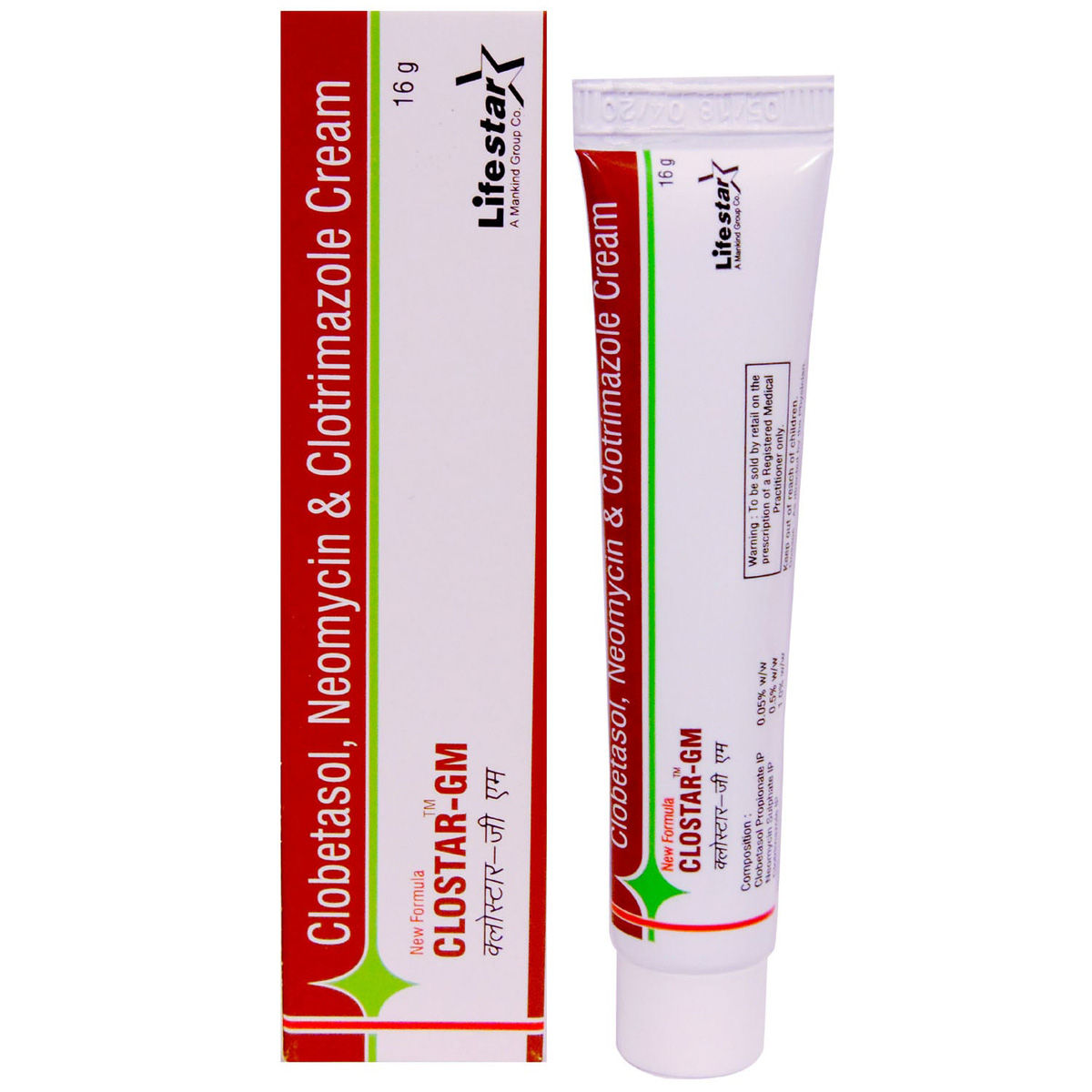Clotebate gm Cream
Clotebate gm Cream is used to treat fungal and bacterial skin infections. Also, it helps to reduce swelling, itching, and redness caused due to certain skin problems. It works by acting inside skin cells and inhibits the release of certain chemical messengers in the body that cause redness, itching, and swelling. It works by damaging fungal cell membranes and kills fungi. Also, it works by inhibiting the production of essential proteins required for bacteria to grow, multiply and increase in numbers, thereby destroying the bacteria. Some people may experience side effects such as dry skin, acne, thinning of the skin, itching, pain, swelling, redness, irritation, or burning sensation at the site of application.
₹62.28*
MRP ₹69.2
10% off
₹58.82*
MRP ₹69.2
15% CB
₹10.38 cashback(15%)
Free Delivery
With Circle membership
(Inclusive of all Taxes)
This offer price is valid on orders above ₹800. Apply coupon PHARMA10/PHARMA18 (excluding restricted items)
Know Your Delivery Time
Provide Delivery Location

Whats That

Secure Payment

India's Most Trusted Pharmacy

Genuine Products
Manufacturer/Marketer :
Consume Type :
Return Policy :
About Clotebate gm Cream
Clotebate gm Cream is a ‘Topical Anti-Infective medicine with Corticosteroids’ used to treat fungal and bacterial skin infections. It also helps to reduce swelling, itching, and redness caused by certain skin problems. Fungal infections can affect our skin and cause infection, which may be contagious (spread from one person to another). Bacterial infection is a condition in which harmful bacteria grow in the body and cause infection, thereby infecting any part of the body.
Clotebate gm Cream is a combination of three drugs: Clobetasol (corticosteroid), Clotrimazole (antifungal), and Neomycin (antibacterial). Clobetasol belongs to the class of corticosteroids that work by acting inside skin cells and inhibiting the release of certain chemical messengers in the body that cause redness, itching, and swelling. When the skin reacts to any allergens, such chemicals are released normally. The fungal cell membranes are essential for their survival as they prevent the entry of unwanted substances into the cells and stop the leakage of cell contents. Clotrimazole belongs to the class of antifungals that works by causing holes in the fungal cell membranes and killing fungi. Neomycin belongs to the antibacterial class that works by inhibiting the production of essential proteins required for bacteria to grow, multiply, and increase in number, thereby destroying the bacteria.
Clotebate gm Cream is only for external use. Use Clotebate gm Cream as prescribed. by the doctor. Avoid contact of Clotebate gm Cream with nose, ears, mouth, or eyes. In case Clotebate gm Cream comes in contact with these areas accidentally, rinse with water thoroughly. Some people may experience dry skin, acne, thinning of the skin, itching, pain, swelling, redness, irritation, or burning sensation at the site of application. Most of these side effects of Clotebate gm Cream do not require medical attention and gradually resolve over time. However, if the side effects worsen or persist, please consult your doctor.
If you are allergic to Clotebate gm Cream or any other medicines, please tell your doctor. Avoid using Clotebate gm Cream for more than 5 days in children and on the face. If you are pregnant or a breastfeeding mother, it is advised to consult a doctor before using Clotebate gm Cream. Clotebate gm Cream is not recommended for children below 2 years of age as the safety and effectiveness were not established. Avoid using Clotebate gm Cream on open wounds or damaged or broken skin. Do not wrap or cover the treated area with airtight dressings unless advised by a doctor. Avoid smoking or going near naked flames as Clotebate gm Cream catches fire and burns easily. You are advised not to scratch or prick the infected areas of your skin as it may spread or worsen the acne. If you have rosacea (redness and often red, small, pus-filled bumps on the face), acne, perioral dermatitis (redness and swelling of the skin around the mouth), psoriasis, glaucoma, cataracts, diabetes, adrenal gland or liver problems, genital itching or other skin problems, inform your doctor before taking Clotebate gm Cream.
Uses of Clotebate gm Cream
Medicinal Benefits
Clotebate gm Cream is a combination of three drugs, namely Clobetasol, Clotrimazole, and Neomycin, used to treat fungal and bacterial infections of the skin. Clobetasol belongs to the class of corticosteroids that work by acting inside skin cells and inhibiting the release of certain chemical messengers in the body that cause redness, itching, and swelling. When the skin reacts to any allergens, such chemicals are released normally. The fungal cell membranes are essential for their survival as they prevent the entry of unwanted substances into the cells and stop the leakage of cell contents. Clotrimazole is an antifungal that works by causing holes in the fungal cell membranes and kills fungi. Neomycin is a broad-spectrum antibiotic that acts against both gram-positive and gram-negative bacteria. It works by inhibiting the production of essential proteins that are necessary for bacteria to grow, multiply and increase in numbers. Thereby destroying bacteria.
Side Effects of Clotebate gm Cream
- Dry skin
- Acne
- Thinning of the skin
- Itching, pain, swelling, redness, irritation or burning sensation at the site of application
Directions for Use
Storage
Drug Warnings
Do not use Clotebate gm Cream if you have inflammatory skin disorders infected with pseudomonas or proteus species of bacteria or viral skin infections like chickenpox, shingles, cold sores or herpes simplex, allergic to Clotebate gm Cream or any other medicines, pregnant or a breastfeeding mother. Avoid using Clotebate gm Cream for more than 5 days in children and on the face. Clotebate gm Cream is not recommended for children below 2 years of age, as the safety and effectiveness were not established. Avoid using Clotebate gm Cream on open wounds or damaged or broken skin. Do not wrap or cover the treated area with airtight dressings unless advised by a doctor. Do not swallow Clotebate gm Cream, and if you accidentally swallow it, consult a doctor immediately. Avoid smoking or going near naked flames as Clotebate gm Cream catches fire and burns easily. You are advised not to scratch or prick the infected areas of your skin as it may spread or worsen the acne. If you have rosacea (redness and often red, small, pus-filled bumps on the face), acne, perioral dermatitis (redness and swelling of the skin around the mouth), psoriasis, glaucoma, cataracts, diabetes, adrenal gland or liver problems, genital itching or other skin problems, inform your doctor before taking Clotebate gm Cream.
Therapeutic Class
Drug-Drug Interactions
Drug-Food Interactions
Diet & Lifestyle Advise
- Regularly change your socks and wash your feet. Avoid shoes that make your feet sweaty and hot.
- In wet places such as changing rooms and gym showers, don’t walk barefoot. Wear flip-flops or sandals to prevent fungal infections.
- Do not scratch the affected area of the skin, as it can spread the infection to other body parts.
- To prevent the spread of infection, avoid sharing towels, combs, bedsheets, shoes, or socks with others.
- Wash your bed sheets and towels regularly.
- Eat foods rich in quercetin (a flavonoid), such as apples, cherries, broccoli, spinach, and blueberries.
- Consuming food rich in probiotics helps in developing the immune system against allergies.
- Limit intake of food that might trigger allergies, such as dairy products, soy, eggs, and nuts.
- Avoid consumption of foods with excess sugar, as it may flare up inflammation.
- Include fruits, vegetables, whole grains, healthy fats, and fish in your diet.
- Avoid getting in contact with harsh soaps, detergents, and rough fabrics.
Habit Forming
How Clotebate gm Cream Works
What if I have taken an overdose of Clotebate gm Cream
Alcohol
Caution
Interaction of Clotebate gm Cream with alcohol is unknown. Please consult a doctor before consuming alcohol while using Clotebate gm Cream.
Pregnancy
Caution
The safety of Clotebate gm Cream in pregnant women is unknown. However, neomycin present in Clotebate gm Cream crosses the placenta and may harm an unborn baby. So it is not recommended for use in pregnant women.
Breast Feeding
Caution
It is unknown whether Clotebate gm Cream is excreted in human milk. It is given to breastfeeding mothers only if the doctor thinks benefits are greater than risks.
Driving
Safe if prescribed
Clotebate gm Cream usually does not affect your ability to drive or operate machinery.
Liver
Caution
If you have any concerns regarding the use of Clotebate gm Cream in patients with Liver problems, please consult a doctor.
Kidney
Safe if prescribed
If you have any concerns regarding the use of Clotebate gm Cream in patients with Kidney problems, please consult a doctor.
Children
Caution
Clotebate gm Cream is not recommended for children below 2 years. However, in children above 2 years, it should be used with caution and in doses only as prescribed by a doctor.
Manufacturer/Marketer address
Author Details
We provide you with authentic, trustworthy and relevant information
Clotebate gm Cream Substitute

Clop-GM Neo Cream 15 gm
₹6.96per tabletTerbinaforce-Plus NF Cream 15 gm
by AYUR
₹4.71per tabletClostar-GM Cream 16 gm
₹3.97per tabletClobet GM RC Cream 10 gm
by AYUR
₹4.32per tabletClop-GM Neo Cream 15 gm
₹6.96per tablet
FAQs
Disclaimer
Product Substitutes













